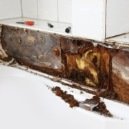Find a pre-screened local mold removal specialist Free Estimate
Find a Mold Specialist Now
Click or Call, Toll-Free 24/7
Does Mold Cause Fibromyalgia?
Can mold cause fibromyalgia? While there may be some connection between fibromyalgia and toxic mold, it’s not nearly as simple as saying that mold causes fibromyalgia. Fibromyalgia is a complex condition involving widespread pain, persistent fatigue and often other symptoms. We know that exposure to toxic mold in the home can cause similar symptoms, but that doesn’t mean it causes fibromyalgia.
So What Does Cause Fibromyalgia?
Doctors don’t know for certain what causes fibromyalgia but it’s believed that a number of factors may contribute to the development of the condition, including genetics, infections, physical and emotional trauma, an imbalance of certain brain chemicals, hormonal abnormalities, muscle abnormalities and disorders of the immune system. The University of Maryland Medical Center(1) suggests that environmental factors (which would include mold) may also play a role. Experts just don’t know for sure if mold can cause fibromyalgia, though, at least not yet.
Common Symptoms of Both Fibromyalgia and Toxic Mold Exposure

Some people suspect that toxic mold might cause fibromyalgia because fibromyalgia and mold-related illness share many of the same symptoms, including:
- Achy joints and muscles
- Fatigue
- Depression
- Headaches or migraines
- General feeling of malaise
People with mold-related illnesses usually have respiratory symptoms, however, such as coughing, sneezing, wheezing, shortness of breath or difficulty breathing, in addition to the symptoms listed above. They may develop sinus infections, bronchitis or pneumonia. These are not symptoms of fibromyalgia.
Still, since many of the symptoms of both conditions are similar, mold-related illness may be misdiagnosed as fibromyalgia in some cases.
Misdiagnosis
Since there are no objective tests for fibromyalgia, like blood tests or x-rays, the condition is simply diagnosed based on the symptoms patients report, after other possible causes of the symptoms have been ruled out. Many doctors fail to consider mold as a possible cause of symptoms, though, and they seldom suggest testing the home for toxic mold in order to determine if mold might be a factor in a patient’s illness.
Of course, if you’re suffering from mold-related illness but are misdiagnosed as having fibromyalgia, you won’t get better with treatment for fibromyalgia. Fibromyalgia is a chronic condition with no cure. While many people with the condition do improve with treatment, some don’t, so doctors may not realize the reason you’re not improving is because you’ve been misdiagnosed.
Getting an Accurate Diagnosis
If you’ve been diagnosed with fibromyalgia and toxic mold has been found in your home, talk to your doctor about whether mold might be the real cause of your symptoms. If you’re not sure if you’ve been exposed to toxic mold or not, but think it might be a possibility, it’s definitely worth getting your home checked for mold. While there is no cure for fibromyalgia, symptoms related to toxic mold exposure usually go away completely once the mold has been removed from the home and treatment has been completed for any mold-related infection. For instance, if you’ve developed bronchitis or pneumonia as a result of mold exposure, you’ll probably need to complete a course of antibiotics in addition to having all mold removed from your home. You can get relief if your symptoms are caused by mold exposure, though, so it’s important to find out for certain if mold is a factor in your condition.
Schedule a Free Home Inspection for Mold
If you suspect there may be a link between your symptoms of fibromyalgia and toxic mold, you can schedule an appointment with a mold remediation professional for a free home inspection. An experienced professional will visit your home, inspect for mold and, if any mold is found, explain the steps necessary to remove the mold and make your home safe again. The inspection and in-home consultation are free, so you have nothing to lose and you have your health to gain. To find qualified mold remediation professionals offering free inspections in your area, just follow the link provided.
Return From Fibromyalgia And Toxic Mold To Our Main Symptoms Page
1. University Of Maryland Medical Center: Fibromyalgia
Free Home Inspection By A Mold Removal Specialist
Search This Website
Recent Articles
-
See Our 5 Recommended Mold Removal Companies in Covington, KY
Apr 16, 25 12:59 PM
-
See Our 5 Recommended Mold Removal Companies in Wheaton, IL
Jun 20, 24 10:33 AM
-
See Our 5 Recommended Mold Removal Companies in Aberdeen, SD
Oct 08, 21 04:05 PM




